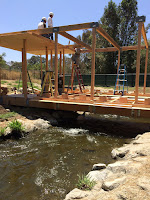The Source of the Water. The Source of the Practice.
"Sensei," the novice monk asked his teacher in the heat of summer, "Which really came first? The tea or the water?"
"OY! It's getting cold," was the wise reply.
What is commonly referred to as the “Japanese Tea Ceremony”, is literally, “tea’s hot water”. Sen no Rikyu (1522-1592), the founder of our Way of Tea, admonished practitioners to pay strict attention to the source of water for tea, to draw it from a pure source at an auspicious time of day.
"OY! It's getting cold," was the wise reply.
What is commonly referred to as the “Japanese Tea Ceremony”, is literally, “tea’s hot water”. Sen no Rikyu (1522-1592), the founder of our Way of Tea, admonished practitioners to pay strict attention to the source of water for tea, to draw it from a pure source at an auspicious time of day.
For the "Water Pavilion" Project of CURRENT:LA the first Los Angeles Public Art Biennial, we practitioners of chado
(the Way of Tea), have been invited by Rirkrit Tiravanija to perform demonstrations in the structure (below) being built over the LA River in Sepulveda Basin Park near Lake Balboa. We will source precious
water from the Los Angeles River that has been purified on site through modern methods and is potable, another of the important aspects of his presentation.
As our water is from the many streams feeding the L.A.
River, the sources of the practice are the many streams of Zen Buddhism. As if
to fortell Los Angeles’ unique cultural diversity, the great teacher Eihei
Dogen Zenji (1200 – 1253) wrote in the Sansui-Kyo (Mountains and Rivers Sutra), “Ikken Shisui” (One View, Four
[Different kinds of] Water). This can be interpreted as not only is there is
water in the world, but there is a world in water. It is not just in water.
Presentation on July 16 (2-3pm) and July 17 (3 - 4pm), 6300 Balboa Ave., Van Nuys
In addition to its practical use in the host’s making a bowl
of green tea for a guest, the notion of “water” will be reflected in the
thematic aspects of today’s presentation of two distinct procedures appropriate
to the summer season and auspicious occasion.
 Meisuidate 名水点
Koichademae: The formal preparation of matcha
(powdered green tea) utilizing water drawn from a famous source.
Upon entering the space, the guest notices the tsurube, an unfinished well bucket made of hinoki cypress
with special paper decorations to denote the purity of the water. This prompts
a request to taste the water from the well bucket before the hot water is added
from the kettle to make a bowl of tea.
Meisuidate 名水点
Koichademae: The formal preparation of matcha
(powdered green tea) utilizing water drawn from a famous source.
Upon entering the space, the guest notices the tsurube, an unfinished well bucket made of hinoki cypress
with special paper decorations to denote the purity of the water. This prompts
a request to taste the water from the well bucket before the hot water is added
from the kettle to make a bowl of tea.
Araijakin 洗茶巾
Usuchademae: As it is
summertime, we will do an informal preparation utilizing a rather shallow tea
bowl that is brought into the preparation area filled with water. A broad leaf (habuta),
with dew drops, stands in for the lid on the fresh water container, all done to
evoke a sense of coolness.
Additionally, poetic names of utensils will reflect the
greater understanding and realization of the purpose of the gathering ... just
that the host makes a bowl of tea for the guest. The guest receives the bowl of
tea from the host.
Thus, the fundamental embodiment of tea preparation, Wa.
Kei. Sei. Jaku. (Harmony.
Respect. Purity. Tranquility.), we hope will be realized.




